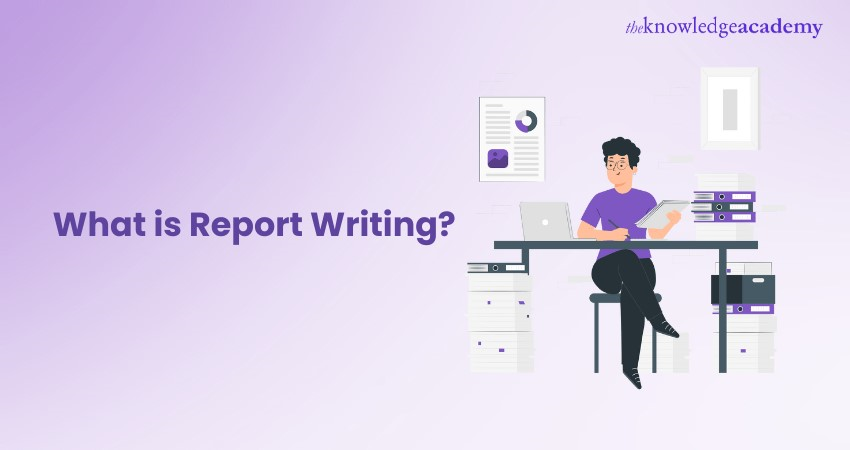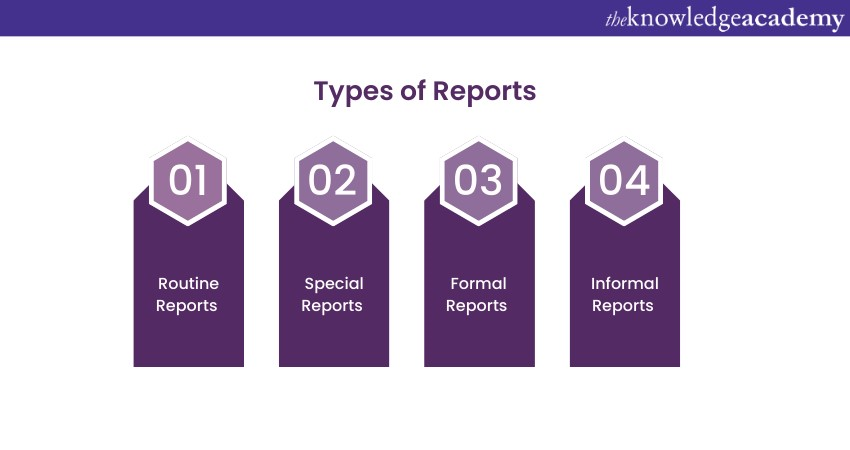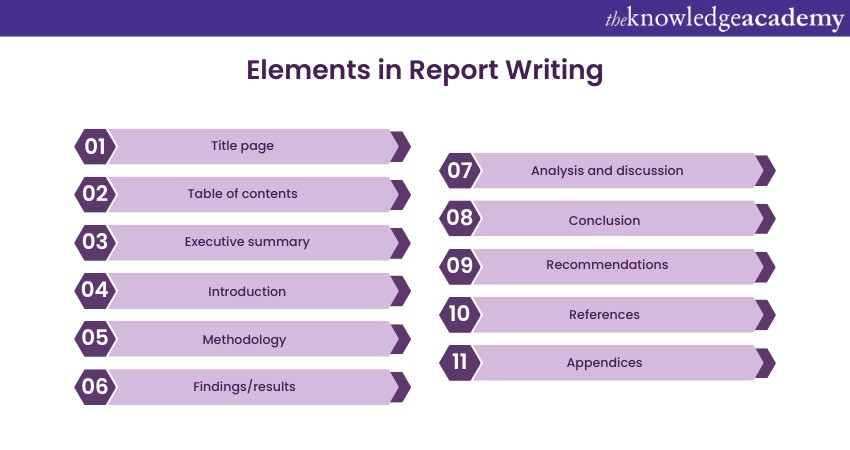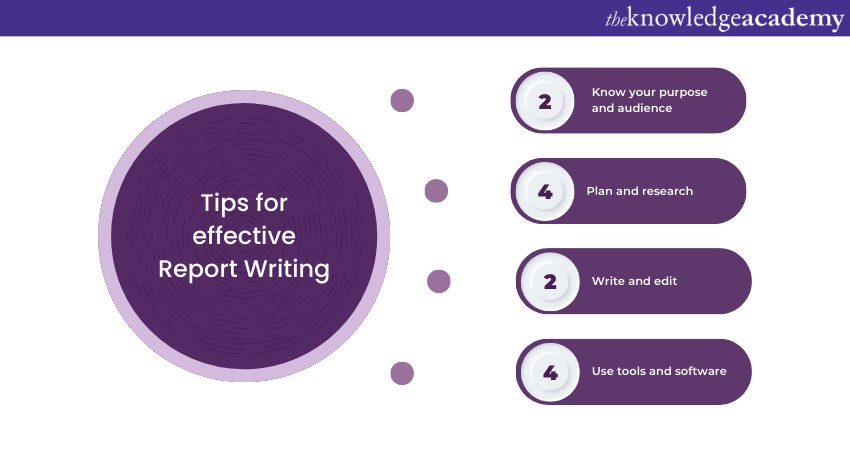We may not have the course you’re looking for. If you enquire or give us a call on 01344203999 and speak to our training experts, we may still be able to help with your training requirements.
Training Outcomes Within Your Budget!
We ensure quality, budget-alignment, and timely delivery by our expert instructors.

Report Writing is a skill that helps you share important information in a clear and organised way. It is like crafting a story with words and sometimes pictures but with a specific purpose and audience in mind. Report Writing can be used for various reasons, such as explaining complex topics, presenting research findings, or making recommendations. But What is Report Writing exactly? How do you write a good Report that meets your goals and expectations?
Well, you're in the right place. In this blog, we will explain What is Report Writing and take you through the world of Report Writing step by step. We'll explore different Report types, learn about the Report Writing format, discover helpful tips, and even distinguish it from other types of writing.
Table of Contents
1) Understanding What is Report Writing?
2) Types of Reports
3) What is the Report Writing format?
4) Tips for effective Report Writing
5) Difference between Project Writing and Report Writing
6) Conclusion
Understanding What is Report Writing?
Report Writing is the process of presenting information in a structured and organised way. It serves as a means of communicating facts, findings, or recommendations to a specific audience, typically in a written format. This type of writing is used in various fields, including academics, business, science, and government, to convey important details and insights.
A Report typically starts with a clear purpose or objective. The Writer gathers relevant information through research, observation, or data collection. This data is then analysed and organised into a coherent document. Reports can vary in length, complexity, and style, depending on the intended audience and purpose.
One of the key aspects of Report Writing is its structure. A typical Report consists of sections such as an introduction, methodology, findings or results, discussion, and a conclusion. These sections help readers understand the context, the process of gathering information, the outcomes, and the significance of the findings.
Reports often include visual aids like charts, graphs, and tables to make complex data more accessible. Additionally, citing sources is essential to provide credibility and allow readers to verify the information.
Types of Reports
Different Types of Reports serve various purposes, and understanding their distinctions is crucial for effective communication in academic, professional, and organisational settings. Here, we'll explore four common types of Reports:

Routine Reports
Routine Reports are regular updates on ongoing activities, often within an organisation. These Reports provide concise information about daily or periodic operations, helping stakeholders stay informed and make informed decisions.
They focus on facts and figures, avoid unnecessary details, and typically follow a standardised format. Examples include daily Sales Reports, Attendance Reports, And Inventory Status Reports. Routine Reports are essential for tracking performance and ensuring smooth operations.
Special Reports
Special Reports are more in-depth and are created for specific purposes, such as investigating a particular issue or analysing a unique situation. These Reports require extensive research and a comprehensive presentation of findings. They are often used to address complex problems or make critical decisions.
For instance, a company might commission a Special Report to evaluate the impact of a new product launch, or a government agency might prepare a Special Report on the environmental impact of a policy change. Special Reports provide a thorough examination of a specific topic and often include detailed recommendations.
Formal Reports
Formal Reports are comprehensive and meticulously structured documents characterised by a standardised format. They usually include a title page, table of contents, executive summary, methodology, findings, discussion, recommendations, and conclusion. Formal Reports are common in academic and corporate environments, as well as in government and research institutions.
They are used to present detailed information and analyses, often for decision-making or academic purposes. A thesis, a business proposal, or an annual Financial Report are examples of Formal Reports. These Reports require a high degree of professionalism and follow strict formatting and citation guidelines.
Informal Reports
Informal Reports are less structured and often used for internal communication within an organisation. They are generally shorter and more straightforward than Formal Reports, emphasising brevity and efficiency. Memos, email updates, and short Progress Reports are common examples of informal Reports.
They serve to share information quickly, often within a department or among team members. Informal Reports are valuable for everyday communication, problem-solving, and decision-making within an organisation, and they do not require the extensive structure and formality of Formal Reports.
Master the art of professional Email communication with our Email Etiquette Training – Boost your online presence and productivity now!
What is the Report Writing format?
Report Writing Format is a way of organising and presenting information in a concise and clear manner. It usually follows a standard structure that can be adapted to different purposes and audiences. A typical Report Writing format consists of the following elements:

a) Title page: This is the first page of the Report that contains the title, the author’s name, the date, and any other relevant information.
b) Table of contents: This is an optional page that lists the sections and subsections of the Report with their corresponding page numbers.
c) Executive summary (or abstract): This serves as a concise summary outlining the key points and discoveries within the Report. It should be written in a clear and concise manner and highlight the purpose, scope, methodology, results, analysis, conclusion, and recommendations of the Report.
d) Introduction: This is the first section of the Report that introduces the topic, background, objectives, and scope of the Report. It should also provide a clear statement of the problem or research question that the Report aims to address.
e) Methodology: This is the section that describes how the data or information was collected and analysed. It should explain the methods, tools, techniques, sources, and criteria used in the research or investigation. It should also mention any limitations or challenges encountered in the process.
f) Findings/results: This is the section that presents the data or information obtained from the research or investigation. It should be organised in a logical and coherent manner, using headings, subheadings, tables, graphs, charts, and other visual aids to illustrate the key points and trends.
g) Analysis and discussion: This is the section that interprets and evaluates the findings or results of the Report. It should explain what the data or information means, how it relates to the problem or research question, and what implications or conclusions can be drawn from it. It should also compare and contrast the findings or results with other relevant sources or literature.
h) Conclusion: This is the final section of the Report that summarises the main points and findings of the Report. It should restate the purpose, objectives, and scope of the Report and provide a clear answer to the problem or research question. It should also highlight the main implications or contributions of the Report to the field or topic of interest.
i) Recommendations: This is an optional section that provides suggestions or actions based on the findings or conclusions of the Report. It should be realistic, feasible, and specific and address any issues or gaps identified in the Report.
j) References: This is a list of sources that were cited or consulted in the Report. It should follow a consistent citation style, such as APA, MLA, Harvard, etc.
k) Appendices: These are additional materials that support or supplement the main content of the Report. They may include data tables, calculations, questionnaires, interview transcripts, etc.
Unleash your creativity and become a master storyteller with our Creative Writing Training - Start your writing journey now!
Tips for effective Report Writing
Here are some tips for effective Report Writing:

a) Know your purpose and audience: Before you start writing, you should have a clear idea of why you are writing the Report and who will read it. This will help you decide what information to include, what tone and style to use, and how to structure and format your Report.
b) Plan and research: You should plan your Report by outlining the main sections and sub-sections and identifying the key points and arguments you want to make. You should also research your topic thoroughly, using reliable and relevant sources and taking notes of the data and evidence you will use to support your claims.
c) Write and edit: You should write your Report in a concise and clear manner, using simple and precise language and avoiding jargon and slang. You should also follow the Report Writing format that suits your purpose and audience and use headings, subheadings, bullet points, tables, graphs, charts, and other visual aids to organise and present your information. You should also edit your Report carefully, checking for spelling, grammar, punctuation, and formatting errors and ensuring that your Report is coherent and consistent.
d) Use tools and software: You can use various tools and software to help you with your Report Writing process. For example, you can use Bing to search for information on your topic or to find examples of Reports written in different formats. You can write and edit your Report, using features such as grammar check, spell check, word count, citation manager, etc, in Google Docs or Microsoft Word. You can also use PowerPoint or Prezi to create and present your Report visually.
|
Project Writing |
Report Writing |
|
|
Purpose |
To demonstrate the student’s ability to apply their skills and knowledge to a specific problem or topic. |
To present the results and findings of a research or investigation on a specific problem or topic. |
|
Format |
No fixed format, but may follow the structure of an essay, with an introduction, body, and conclusion. |
Fixed format, with a title page, table of contents, summary, introduction, methodology, findings/results, analysis/discussion, conclusion, recommendations, references, and appendices. |
|
Features |
Creative and flexible. May include personal opinions, reflections, or recommendations. |
Formal and objective. Based on reliable sources and data. Avoid personal opinions or bias. |
|
Examples |
Business plan, marketing campaign, software development, case study analysis, etc. |
Business plan, marketing campaign, software development, case study analysis, etc. |
a) Purpose: Project Writing is usually done to demonstrate the student’s ability to apply their skills and knowledge to a specific problem or topic. Report Writing is usually done to present the results and findings of a research or investigation on a specific problem or topic.
b) Format: Project Writing does not have a fixed format, but it may follow the structure of an essay, with an introduction, body, and conclusion. Report Writing has a fixed format, with a title page, table of contents, summary, introduction, methodology, findings/results, analysis/discussion, conclusion, recommendations, references, and appendices.
c) Features: Project Writing is more creative and flexible than Report Writing. It may include personal opinions, reflections, or recommendations. Report Writing is more formal and objective than project writing. It should be based on reliable sources and data and avoid personal opinions or bias.
d) Examples: Some examples of Project Writing are a business plan, a marketing campaign, a software development, a case study analysis, etc. Some examples of Report Writing are a Lab Report, a Market Research Report, a Scientific Report, a Feasibility Report, etc.
Project Writing and Report Writing are different types of academic writing that require different skills and approaches. You should always check the requirements and expectations of your course and module handbooks, instructions from your lecturer, and your subject conventions before you start writing.
Unlock the power of effective communication with our Report Writing Training - Start crafting impactful Reports today!
Conclusion
Report Writing is a crucial skill that can open doors to various opportunities in your academic and professional life. By understanding What is Report Writing, the types of Reports, Report Writing formats, and following effective tips, you can become a proficient Report Writer. Moreover, recognising the differences between project writing, article writing, and Report Writing will help you choose the right approach for your communication needs. Finally, with the help of modern Report writing software, you can streamline the process and create impressive Reports that convey your message effectively.
Transform your potential into excellence - Join our Personal Development Training and embark on a journey of self-improvement!
Frequently Asked Questions
Upcoming Business Skills Resources Batches & Dates
Date
 Report Writing Course
Report Writing Course
Fri 7th Jun 2024
Fri 16th Aug 2024
Fri 4th Oct 2024
Fri 6th Dec 2024







 Top Rated Course
Top Rated Course



 If you wish to make any changes to your course, please
If you wish to make any changes to your course, please


